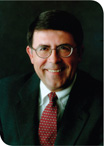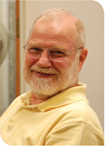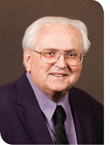 Ken Dobbins
Ken Dobbins
Southeast Missouri State University
Ask Ken Dobbins to describe a single event that defines his tenure at Southeast Missouri State University, and he’ll cite not one, but 50. That’s the number of commencement exercises he’s participated in as executive vice president or, since 1999, as president of the university based in Cape Girardeau. “I probably shook the hands of more than 35,000 students” getting their degrees, he says. Among them, teachers, doctors, engineers, artists and actors.
At Southeast, perhaps above all other state-system universities, graduation is a very big deal, indeed. “Southeast Missouri State is in one of the poorest congressional districts in the nation,” Dobbins says. “The one thing I believe in as a first-generation college graduate—I had 27 cousins, and only one other followed me—is that education can make the difference.” Graduation, then, is truly a celebration there. “We’ve been able to change their lives and their families’ lives, and the lives of many of the people they come into contact with,” Dobbins says. “We recognize that twice a year, but then too often it’s over, people move on and forget about what they were able to do to graduate and why it was so important.”
If anyone leading a state-funded university in Missouri is qualified to get deep in the weeds of higher-education finance, it’s Ken Dobbins. He brings to his duties not just 10 years’ worth of management consulting from his days in the Air Force, but an accountant’s perspective reinforced with the organizational skills of an MBA holder. “In some ways, that’s a little different perspective,” he acknowledges. “I think I might understand financial issues faster than some because of my background in business, but at Kent State, where I was an adjutant assistant professor, I served on some dissertation committees, so there’s a little of both with management and academic work.”
That background also has given him a finely tuned malarkey detector, which can be useful on occasion. “When someone tells you that something’s being done one way because they’ve always done it that way, then I know from my experiences that you’d better look at it and look at it closely,” Dobbins says.
It’s somewhat ironic that as Southeast has experienced tremendous growth in total enrollment, surging from roughly 7,900 as recently as 1995 to nearly 11,000 this year, state funding per student has declined sharply. Helping students navigate that challenge to complete their degrees requires a leadership team that completely buys into the vision, Dobbins says.
But something else sets Southeast apart on his watch—belief in the power of collaboration for strategic planning—even the students. “Everyone plays a part, some more than others,” he says. “We believe that we need to have inclusion in the process, because that will help people buy in, with everyone understanding where we are and where we’re going to go,” Dobbins says.
 James Shortridge
James Shortridge
University of Kansas
The subject matter itself may be geography, but for James Shortridge, what plays out with the people living on the land is as important as geography itself—and not just today, but well into the past. “I call myself a cultural and historical geographer,” he says. “I’ve written a book on the mindset of the Midwest, several on Kansas, and last month, my book on Kansas City came out. It’s fascinating trying to understand the middle part of the country, what makes it tick and the role it plays.”
The Midwest as a sense of place has held that fascination since he left his native Cass County for Dartmouth College in New Hampshire. That, he said, is when “I became aware that the Midwest was a separate work, different from New England, a place people have a hard time defining not just where it is, but what it is.”
Exploring that fuzziness led him back to the Midwest and the University of Kansas, where he went on to earn his master’s and doctorate—and where this son of Pleasant Hill was thrust into a cultural clash more than a century old. Shortridge was raised in a part of Missouri that was often in flames during the run-up to the Civil War, and some of his relatives had a hard time wrapping their minds around the notion that one of their own was attending classes not just in Kansas, but in Lawrence. “For a while, I had a few aunts who didn’t think too highly of me,” he chortles.
That clash of cultural values is exactly what intrigues him. “People spend time talking about race, gender and social class and why it’s important,” he says. “Those are big issues, but what I argue is that the region you’re from is probably just as important. I’m convinced that if I had grown up in Alabama, California or New Jersey, I’d be quite a different person. The Midwest sinks into you somehow, it influences the person you become. It’s interesting to ponder.”
One ponderable of interest to many in this region is the dynamic of the state line running through Kansas City. “Kansas City is, I think, pretty much unique,” he says. “In a lot of other cities divided by state lines, there’s overlap, but in almost every case, all of the power is on one side,” as in Chicago, with exurbs that spill into Indiana, or St. Louis. “But here, the really unusual thing is the development of Johnson County to be a power, and having that sharing of power. It underlies the issues you see every day.”
During his tenure in Lawrence, Shortridge has advised roughly 40 students on their doctoral theses, and a like number of master’s degree students on their research. He has a special appreciation for those who have gone on to study geography in graduate school, because he knows and understands what they’re giving up—and why. “Cultural geography,” he says, “is not something you’re going to get rich in—people come to it for the love of this stuff.”
 Lora Lacey-Haun
Lora Lacey-Haun
University of Missouri–Kansas City
Throughout her nearly 40 years of nursing education, most of it in Kansas City, Lora Lacey-Haun has been ahead of the curve: She became a nurse practitioner before it became a hot specialty, she’s long pushed for greater student-body diversity at the University of Missouri-Kansas City, and she’s fostered innovative approaches to student retention. Not a bad track record for this native Alabamian, who came to the Midwest in 1981. She’ll retire this year from UMKC, where she’s been a professor, assistant dean and, since 2004, dean of the School of Nursing.
What led her down that path? Kids: “When I was going through school taking clinical courses, I thought about obstetrics or orthopedics. But when I took that pediatrics course, I knew where I wanted to be.” She went on to graduate school, again at the University of Alabama-Birmingham, and was one of three students in a pilot program to teach pediatric nurse-practitioner courses. The dean of that nursing school ended up taking a similar role at UMKC and invited her to apply for a faculty position here. “I didn’t intend to stay,” she says, “but I had two children, developed friendships, the relationship and the job grew, and 32 years later, I’m still here. And I’d promised my parents I’d be back in a couple of years!”
Much would change at UMKC after that. The School of Nursing wasn’t seen as part of Truman Medical Center the way it is today, but decades of efforts to develop new partnerships for faculty or students have paid off. Now, “people tell me how strong our students are, how our students are hiring priorities for a lot of hospitals,” Lacey-Haun says. Lacey-Haun has helped create or promote to increase access for prospective students—and help them stay on track—as well as to recruit students from the urban core who understood the challenges of life and health care in that part of the metropolitan area. “Being a School of Nursing in an urban-serving university means you recruit students from the urban core,” she said. “It means you help them be successful and develop their own careers—that’s really exciting, and you become personally attached to those students.”
Attachments that, on occasion, compel you to help some get past the finish line when a bad break can mean the difference between graduating and dropping out. One answer to that was the Student Success Program Lacey-Haun helped develop. “We would have students come to us that hadn’t eaten all weekend; now, we keep a storage of canned goods for those who need that kind of support,” she said. “We have emergency aid money, and used that for one student who was ready to drop out just because she had a flat tire, and no way to get to campus.” Absent a program like that, she said, any other student might have been lost. “That student graduated and has gone on and now she’s a registered nurse, but otherwise, she’d still be at a job making minimum wage, if that.”
 Barry Flinchbaugh
Barry Flinchbaugh
Kansas State University
For more than 40 years, Barry Flinchbaugh has been agricultural policy personified in the state of Kansas. He’s advised state legislators as well as U.S. senators and representatives in Washington, and he’s counseled state and federal ag department officials. The true measure of his legacy, though, might well be the 3,500 students he’s helped educate with his straight-talking approach to agricultural economics. “They’re in every state and many foreign countries, and they’re doing great things,” Flinchbaugh says. “I took them from the theoretical to the practical, taught them the policy-making process. If you go to Washington, you’ll see Flinchbaugh students all over the place.”
At 70, he’s trimmed down the course load in Manhattan, teaching one section of ag econ each semester. Seats in that section are prized commodities, and routinely fill up almost as soon as they’re available. But his legacy lives in the congressional aides, lobbyists, and members of the executive branch who administer current farm policy. He’s still a major player on the national scene, even though turnover in Washington has taken its toll. At one time, Pat Roberts was chairman of the House Agriculture Committee, former Congressman Dan Glickman was Agriculture Secretary and Bob Dole was the Senate majority leader—“and I had the ear of all three,” Flinchbaugh says, reflecting on the zenith of his policy influence. “That was invaluable and that would rub off. When Kansas State went for something, political leaders had a good taste in their mouths because we had helped them out on a hot issue.”
A native of Pennsylvania, Flinchbaugh earned his bachelor’s degree at Penn State and his master’s in ag economics at Purdue. When confronted with three career possibilities at the dawn of the 1970s, he passed up chances to work at Ohio State and Michigan State in favor of Kansas. “If you’re going to do ag policy work, where better to do it than in Kansas?” he asks. “It’s wheat country, the farmers are very much at the forefront. It appeared to me to be an ideal situation.”
He liked the situation, the town and the state—he found some comfort with the values and attitudes of farmers descended from German immigrants. The hook was set. “I’ve had opportunities; I’ve interviewed periodically all over the country and in Washington, but frankly, I’ve never found anything I thought was better than being at K-State or a place where I would be treated more respectfully than I was in Kansas.” And the university reaped rewards, as well.
But the real clincher for him has been the ability to be himself. “I haven’t had to kowtow to the powerful; I can speak the way it is, or the way I think it is, and have a certain amount of independence,” he says. “I used to put it this way: I never wanted to work any place where I couldn’t tell the boss to go to hell and survive. I’ve told that to a dean or two and a president or two—and here I am.”
 Ken Bingman
Ken Bingman
Blue Valley West High School
A career teaching biology was almost pre-ordained: Ken Bingman grew up on a farm in southwest Missouri, and the family’s livelihood, he says, “was totally dependent on how well our animals grew and reproduced.” And how well the corn, wheat, soybeans and barley turned out.
“I remember the first time we used commercial fertilizer and saw a dramatic increase in the bushels per acre,” Bingman says. “I wanted to know how this dry powder could make such a huge difference in plant growth.” Variations in size and rate of growth in cows, hogs, chickens and other livestock also intrigued him: “I wanted to know what caused some animals to be much more desirable than others.”
Biology, then, was the answer, and he found the meaningful explanations to his questions both rewarding and invigorating, sensations he’s tried to inspire in his students at Blue Valley West High School. His 51st year of teaching wraps up a path that took him from Wyandotte High School for four years and Shawnee Mission West for 35 more before he started at Blue Valley in 2001. Bingman’s early interest in biology was magnified by two of his three older brothers who were also on science and biology tracks. “Both of them were excited about understanding biology and sharing those understandings with students,” Bingman remembers. “They would come home with so much enthusiasm about what they were learning and how it applied to our lives. I was fascinated with their explanations of how the natural world worked.”
Even as a teenager, Bingman knew what he would spend his life doing. “I had a compelling mission and clear focus early in my high school and college experience,” he says. “That mission and focus continues to this day.” A stellar example of that mission in action occurred with a group of students studying cell reproduction. Searching for an explanation of that process, the students came up with various answers before the light bulb finally came on as they probed the role played by hydrogen bonding. “The momentum was building for a big a-ha! moment,” Bingman says, and the students relished the excitement and the experience of learning about the central dogma of biology.
All of what he’ll take away from teaching upon his retirement—the sense of accomplishment, the pride, the fulfillment as a professional—he owes to his students. “”The greatest and neatest things I have learned about teaching, I have learned from students. I absolutely love their enthusiasm for learning and life.” History, he says, tells us that Ponce de Leon was looking for the Fountain of Youth, and he didn’t find it because he looked in the wrong place: “The Fountain of Youth is in the youth,” he says. “Working with them will keep one eternally young through their love of life, laughter, and learning. If I had it all to do again, I would become a high school biology teacher. I wish I had another 50 years, with our advances in understandings. Wow: How exciting and challenging that would be!”